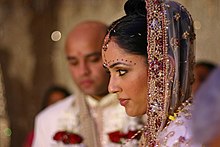Ghoonghat: Difference between revisions
Niceguyedc (talk | contribs) m v1.36 - disambiguate Punjab |
m 1 pic added of modern ghoonghat |
||
| Line 6: | Line 6: | ||
==Usage== |
==Usage== |
||
[[File:HinduBrideIndia.jpg|thumb|A modern [[Hindu]] bride with ghoonghat over her head.]] |
|||
The ghunghat varies in style due to personal choice and tradition. Most wearers cover only the forehead, ears, and eyes; this allows them to see through the garment whilst being veiled. A popular style is to pull the fabric from the side of the face and hold it there whilst talking to males; this forms a quick barrier between the speakers and is the most convenient form of the ghunghat. |
The ghunghat varies in style due to personal choice and tradition. Most wearers cover only the forehead, ears, and eyes; this allows them to see through the garment whilst being veiled. A popular style is to pull the fabric from the side of the face and hold it there whilst talking to males; this forms a quick barrier between the speakers and is the most convenient form of the ghunghat. |
||
Revision as of 20:25, 6 December 2015
In Northern India, a ghoonghat (ghunghat or jhund) is a veil or headscarf worn by women to cover their head, and often their face. Generally a pallu (the loose end of a sari) is pulled over the head to act as a ghunghat. A dupatta (long scarf) is also sometimes used as a ghungat.
Purpose
In ghungat, a woman will veil her face from all men to whom she's related by marriage and who are senior to her husband. This would include, for example, her husband's father, elder brother and uncles. The effect of ghungat is to limit a young woman's interaction with older men.[1][2]
Usage

The ghunghat varies in style due to personal choice and tradition. Most wearers cover only the forehead, ears, and eyes; this allows them to see through the garment whilst being veiled. A popular style is to pull the fabric from the side of the face and hold it there whilst talking to males; this forms a quick barrier between the speakers and is the most convenient form of the ghunghat.
In traditional rural areas, women use their sari to completely cover the face and neck, concealing their identity to males. There is a small minority of women that use the fabric to cover their whole face, chest, arms, and stomach. This type of veiling is still popular with Hindu brides and is observed on the wedding day. Many new brides will use the ghungat until their father-in-law advises to unveil. This is to keep the modesty of the bride.
Traditionally, in some parts of India, women are supposed to wear a ghunghat in front of family elders and male guests, father-in-law, elder brothers of her husband, except when only in front of other women, husband and younger male family members. The ghunghat is used to show respect to elder males of the extended family. In desert areas of India and Pakistan, the ghungat is used to keep sand from blowing onto the face.
The ghungat was popular in India until at least the 1930s, but its usage has steadily declined since, particularly in urban areas. However, the ghunghat is still in use in rural parts of northern India, especially in Punjab, Himachal Pradesh, Haryana, Rajasthan, Jammu and Kashmir, Uttar Pradesh, Bihar, Uttarakhand, Gujarat, Madhya Pradesh.
References
- ^ Guindi, Fadwa El (2003). Veil: modesty, privacy and resistance (Repr. ed.). Oxford [u.a.]: Berg. pp. 109–111. ISBN 1859739296.
- ^ Nevile, Pran (2006). Lahore: a sentimental journey. New Delhi, India: Penguin Books. p. 77. ISBN 0143061976.
